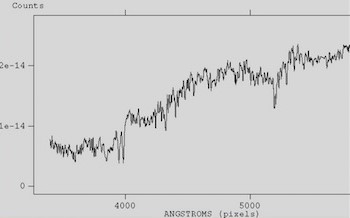Multiple Stellar Populations from a Single Galaxy Spectrum
This has wide potential applications to chemical and dynamical studies of galaxies from two-dimensional integral field unit (IFU) spectroscopy.
Research themes
Project status
Content navigation
About

The integrated spectrum of an early type (mainly older stars) disk galaxy. The two absorption lines near 3950 A are Ca lines, and the strong feature near 5200 A is from Mg. The weaker features include Fe and C moleculular lines. The strength of the lines depends on the fraction of these elements present in the stars, and the widths of the lines depends on the random motions of the stars.
The integrated spectrum of the starlight in a galaxy provide several different kinds of information about the stellar population in the galaxy. The strengths of the absorption lines reflect the kinds of stars that make up the galaxy, and the shapes and precise wavelengths of the absorption lines allow us to estimate how fast the stars are moving around the galaxy, and also how large their random motions are. Often the galaxy is made up of multiple stellar populations (say young and old stars), and it would be very useful to extract the properties of more than one stellar population from their combined integrated spectrum.
In a project aimed at studying the dark matter in disk galaxies, one of our PhD students has just finished her thesis, on measuring the random velocities for two coexisting stellar populations in the disks of spirals from a single spectrum of the integrated light. Her method used direct analysis of the spectra, and it worked very well. I think there may be a more powerful (Fourier) method for extracting the individual spectra of multiple populations from a single spectrum of the integrated light. The project would be to develop this method. This has wide potential applications to chemical and dynamical studies of galaxies from two-dimensional integral field unit (IFU) spectroscopy.
For more information regarding this project, please contact the project supervisor.

